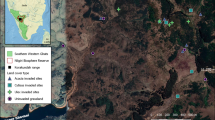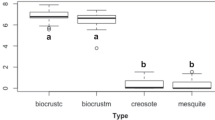Abstract
This study examines the impacts of woody, N2-fixing invasive Acacia spp. on the patterns of nutrient cycling in two invaded ecosystems of differing nutrient status in the Cape floristic region. Patterns of soil nutrient mineralization were measured by a field incubation method while the significance of the fixation process in altering nutrient cycling was assessed by the δ15N natural abundance technique. The results confirm earlier reports that invasion by woody shrubs results in organic matter and nutrient enrichment of surface soils of both ecosystems. However, patterns of nutrient availability (phosphorus and nitrogen) were not necessarily enhanced. In the more fertile strandveld both phosphorus and nitrogen (significant at P<0.10) showed trends towards enhanced annual mineralization rates upon invasion, while in the low nutrient fynbos system only phosphorus followed this trend. It is unclear whether this differential response is a consequence of plant- or soil-derived feedbacks on the decomposition processes in each system. The δ15N values of the soils from the invaded sites of both ecosystems indicated a strong influence of the alien species on the soil nitrogen component. However, as with other studies of natural ecosystems, the contribution of nitrogen from fixation could not be readily quantified with the δ15N natural abundance method because of problems in selecting suitable non-N2-fixing reference plants. A technique of disrupting nodule structure and function, by fumigation with O2, to obtain the δ15N value of a non-N2-fixing speciment of the study species was tried and found to overcome some of the problems associated with the lack of suitable reference plants. With this technique it was possible to detect the almost total dependence of A. saligna on N2-fixation in the fynbos soils with their low nitrogen mineralization rates. In the strandveld ecosystem with much higher soil nitrogen release rates A. cyclops was only partly dependent on fixation (about half) for its nitrogen. The nutrient enrichment of both ecosystems and trends towards enhanced rates of nutrient mineralization could have profound implications on the long-term success of alien invader clearing operations and the restoration of the indigenous flora at these sites.
Similar content being viewed by others
References
Adams MA, Polglase PM, Attiwill PM, Weston CJ (1989) In situ studies of nitrogen mineralization and uptake in forest soils; some comments on methodology. Soil Biol Biochem 21: 423–429
Allsopp N, Stock WD (1993) Mycorrhizal status of plants growing in the Cape Floristic Region. Bothalia 23: 91–104
Beare MH, Parmelee RW, Hendrix PF, Cheng W, Coleman DC, Crossley DA (1992) Microbial and faunal interactions and effects on litter nitrogen and decomposition in agroecosystems. Ecology 62: 569–591
Dakora FD, Atkins CA (1989) Diffusion of oxygen in relation to structure and function in legume root nodules. Aust J Phys 16: 131–140
Dakora FD, Atkins CA (1990) Morphological and structural adaptation of nodules of cowpea to functioning under sub-and supara-ambient oxygen pressure. Planta 182: 572–582
Dean SJ, Holmes PM, Weiss PW (1986) Seed biology of invasive alien plants in South Africa and Namibia. In: Macdonald IAW, Kruger FJ, Ferrar AA (eds). The ecology of biological invasions in southern Africa. Oxford University Press, Cape Town, 157–170
Fog K (1988) The effect of added nitrogen on the rate of decomposition of organic matter. Biol Rev 63: 433–462
Handley LL, Raven JA (1992) The use of natural abundance of nitrogen isotopes in plant physiology and ecology. Plant Cell Environ 15: 965–985
Hansen AP, Pate JS (1987) Evaluation of the 15N natural abundance method and xylem sap analysis for assessing the N2-fixation of understorey legumes in jarrah (Eucalyptus marginata Donn ex Sm.) forest in S.W. Australia. J Exp Bot 38: 1446–1458
Hansen AP, Pate JS, Hansen A, Bell DT (1987) Nitrogen economy of post-fire stands of shrub legumes in jarrah (Eucalyptus marginata Donn ex Sm.) forests of south western Australia. J Exp Bot 38: 26–41
Högberg P (1990) 15N natural abundance as a possible marker of the ectomycorrhizal habit of trees in mixed African woodlands. New Phytol 115: 483–486
Milton SJ (1981) Litterfall of the exotic acacias in the south western Cape. J Sth Afr Bot 47: 147–155
Mitchell DT, Coley PGF, Webb S, Allsopp N (1986) Litterfall and decomposition processes in the coastal fynbos vegetation, south-western Cape, South Africa. J Ecol 74: 977–993
Musil CF, Midgley GF (1990) The relative impact of invasive Australian acacias, fire and season on the soil chemical status of a sandplain lowland fynbos community. S Afr J Bot 56: 417–419
Murphy J, Riley JP (1962) A modified single solution method for the determination of phosphate in natural waters. Anal Chim Acta 27: 31–36
Pate JS, Stewart GR, Unkovich M (1993) 15N natural abundance of plant and soil components of a Banksia woodland ecosystem in relation to nitrate utilization, life form, mycorrhizal status and N2-fixing abilities of component species. Plant Cell Environ 16: 365–373
Reenen CA van, Visser GJ, Loos MA (1992) Soil microorganisms and activities in relation to season, soil factors and fire. In: Van Wilgen B, Richardson DM, Kruger FJ, Van Hensbergen HJ (eds) Fire in South African mountain fynbos. Springer, Berlin Heidelberg New York, pp 258–272
Schulze ED, Gebauer G, Ziegler H, Lange OL (1991) Estimates of nitrogen fixation by trees on an aridity gradient in Namibia. Oecologia 88: 451–455
Sealy J (1986) Stable carbon isotopes and prehistoric diets in the south-western Cape Province, South Africa (Cambridge monographs in African archaeology 15). British Archaeological Reports, Oxford
Shearer G, Duffy J, Kohl DH, Commoner B (1974) A steady-state model of isotopic fractionation accompanying nitrogen transformations in soils. Soil Sci Soc Am Proc 38: 315–322
Shearer G, Kohl DH (1986) N2-fixation in field settings: estimations based on natural 15N abundance. Aust J Plant Phys 13: 699–756
Shearer G, Kohl DH (1989) Estimates of N2 fixation in ecosystems: the need for and basis of the 15N natural abundance method. In: Rundel PW, Ehleringer JR, Nagy KA (eds). Stable isotopes in ecological research (Ecological Studies 68). Springer, Berlin Heidelberg New York, pp 342–374
Sibbesen E (1977) A simple ion-exchange resin procedure for extracting plant-available elements from the soil. Plant Soil 46: 665–669
Sofer Z (1980) Preparation of carbon dioxide for stable carbon isotope analyses of petroleum fractions. Anal Chem 52: 1389–1391
Stock WD (1983) An evaluation of some manual colorimetric methods for the determination of inorganic nitrogen in soil extracts. Comm Soil Sci Plant Anal 14: 925–936
Stock WD, Lewis OAM (1984) Uptake and assimilation of nitrate and ammonium by an evergreen fynbos shrub species Protea repens L. (Proteaceae). New Phytol 97: 261–268
Stock WD, Lewis OAM, Allsopp N (1988) Soil nitrogen mineralization in a post-fire coastal fynbos succession at Pella, south western Cape, South Africa. Plant Soil 106: 295–298
Stock WD, Allsopp N (1992) Functional perspective of ecosystems. In: Cowling RM (ed). The ecology of fynbos: nutrients, fire and diversity. Oxford University Press, Cape Twon, pp 241–259
Virginia RA, Delwiche CC (1982) Natural 15N abundance of presumed N2-fixing and non-N2-fixing plants from selected ecosystems. Oecologia 54: 317–325
Vitousek PM, Walker LR (1989) Biological invasion by Myrica faya in Hawaii: plant demography, nitrogen fixation, ecosystem effects. Ecol Monogr 59: 247–265
Vitousek PM, Shearer G, Kohl DH (1989) Foliar 15N natural abundance in Hawaiian rainforest: patterns and possible mechanisms. Oecologia 78: 383–388
Wedin DA, Tilman D (1990) Species effects on nitrogencycling: a test with perennial grasses. Oecologia 84: 433–441
Witkowski ETF (1991a) Growth and competition between seedlings of Protea repens and the alien invasive Acacia saligna, in relation to nutrient availability. Funct Ecol 5: 101–110
Witkowski ETF (1991b) Effects of invasive alien acacias on nutrient cycling in the coastal lowlands of the Cape fynbos. J Appl Ecol 28: 1–15
Witkowski ETF, Mitchell DT (1987) Variations in soil phosphorus in the fynbos biome, South Africa. J Ecol 75: 1159–1171
Author information
Authors and Affiliations
Rights and permissions
About this article
Cite this article
Stock, W.D., Wienand, K.T. & Baker, A.C. Impacts of invading N2-fixing Acacia species on patterns of nutrient cycling in two Cape ecosystems: evidence from soil incubation studies and 15N natural abundance values. Oecologia 101, 375–382 (1995). https://doi.org/10.1007/BF00328825
Received:
Accepted:
Issue Date:
DOI: https://doi.org/10.1007/BF00328825




